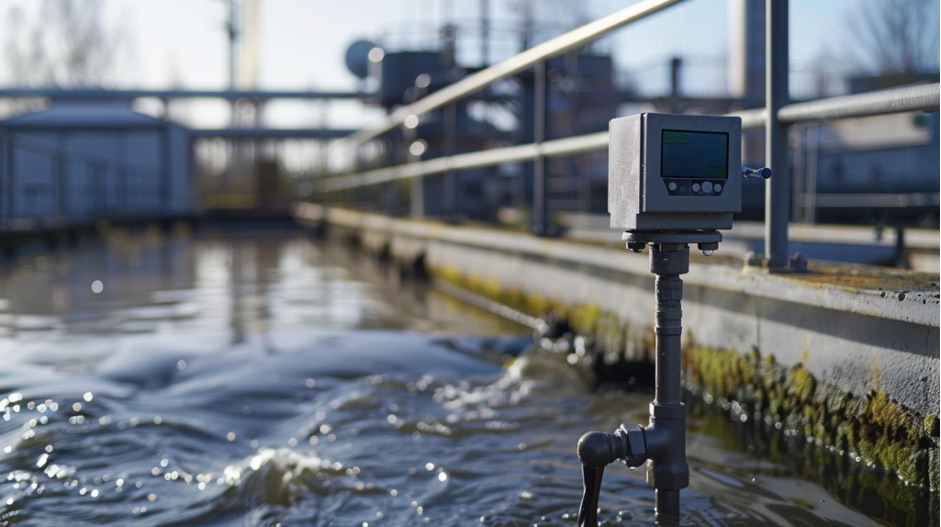At
a time when the cleanliness of water and air is a top priority, TOC
(Total Organic Carbon) analysis plays a central role. It enables us to
precisely measure and monitor organic contaminants.
By
using advanced NDIR (non-dispersive infrared) sensors, we can tackle
these challenges with high precision and reliability. The development
and perfection of our sensors reflect our long-standing commitment to quality and innovation.
As a leading manufacturer of NDIR sensors, we understand the growing need to provide accurate and rapid analytical methods for
assessing water and air quality. Our sensors are the result of
intensive research and development and are in line with our commitment
to environmental protection and sustainability. They enable
environmental engineers and scientists to effectively monitor
concentrations of organic carbon compounds, which is essential for
meeting regulatory environmental standards and ensuring public health.
This technology not only supports a sustainable environmental strategy, but also provides the flexibility to adapt to new regulatory requirements and environmental conditions.
The most important points summarized:
-
NDIR sensors (Non-Dispersive Infrared) are used for precise and reliable measurements of organic contaminants.
-
The manufacturer has a long-standing commitment to quality and innovation in the development of NDIR sensors.
-
There is a growing need for fast and accurate analytical methods to assess water and air quality.
-
As a result of intensive research, NDIR sensors support environmental
engineers and scientists in the effective monitoring of organic carbon
compounds.
-
This technology contributes significantly to compliance with legal environmental standards and ensures public health.
-
The flexibility of the sensor technology makes it possible to adapt to
new regulatory requirements and environmental conditions.
-
The development of the sensors is in line with environmental protection and sustainability.
Basics of TOC analysis
TOC
(Total Organic Carbon) analysis has established itself as an
indispensable tool for effectively monitoring organic pollution in water
and air. This method measures the total organic carbon in a sample,
which serves as a reliable indicator of the presence and extent of
organic pollution. Its application is not limited to the measurement of
pollution; rather, it is a critical component in the assessment of water quality in a variety of industrial and environmental contexts.

TOC
analysis makes a significant contribution to increasing the operational
efficiency of water treatment plants. It ensures precise compliance
with both wastewater and drinking water regulations by providing fast and accurate measurement data. This data is essential for monitoring and controlling water treatment
processes, which is particularly important in industries such as
chemical and pharmaceutical production and in municipal waterworks.
With its ability to provide accurate results quickly, TOC analysis not only enables continuous monitoring of water quality, but also
proactive management of potential ecological risks. It supports
environmental engineers and managers in reacting to changes in water
composition at an early stage and taking appropriate measures to reduce
environmental pollution.
TOC analysis is also a key tool in environmental monitoring.
It helps to quickly identify and quantify ecological pollution, which
enables a prompt response to environmental problems. This is
particularly important in order to prevent long-term environmental
damage and effectively protect natural resources.
The most important points summarized:
-
TOC analysis is essential for monitoring organic contamination in water and air.
-
It measures the total organic carbon in samples and serves as an indicator for organic contamination.
-
TOC analysis is used in industrial and environmental contexts to assess water quality.
-
TOC analysis is used to increase the operating efficiency of water
treatment plants by ensuring precise compliance with water regulations.
-
It plays an important role in the monitoring and control of water
treatment processes, particularly in the chemical and pharmaceutical
industries and in municipal waterworks.
-
It enables continuous monitoring of water quality and proactive management of ecological risks.
-
It supports environmental engineers and managers in reacting to changes
in water composition at an early stage and taking environmentally
friendly measures.
-
It is an important tool in environmental monitoring for the rapid
identification and quantification of ecological impacts and the
prevention of long-term environmental damage.
Technical process of TOC analysis
TOC
(Total Organic Carbon) analysis is a complex and multi-stage process
that begins with the meticulous collection of a water or air sample.
This initial phase is crucial as the quality and consistency of the
sampling directly influences the reliability of the analysis results.

After
the sample has been taken, it is introduced into a TOC analyzer. Inside
the analyzer, the sample undergoes a special process to convert all
organic compounds into carbon dioxide (CO2 ). This conversion is usually done either by high-temperature combustion or by UV persulphate oxidation, depending on which method best suits the specific requirements of the analyzer and the sample to be tested.
After the oxidation of the organic materials to CO2 , the NDIR sensor (non-dispersive infrared sensor) takes on a critical
function in the analysis process. It measures the concentration of CO2 in the sample by detecting the amount of infrared light that the CO2 absorbs. The amount of light absorbed correlates directly with the
concentration of organic carbon in the sample. In this way, the NDIR
sensor enables precise quantification of the total organic carbon, which in turn provides a direct measure of the organic load in the sample under investigation.
Thanks
to this detailed and precise measurement, TOC analysis enables an
effective assessment of organic pollution in water and air samples. This
is of crucial importance for:
-
environmental monitoring,
-
industrial processes
-
and compliance with statutory environmental standards.
The
results of the TOC analysis provide valuable information that can
contribute to the control and improvement of environmental quality by
making it possible to precisely identify contaminants, determine their
sources and initiate suitable measures to reduce or eliminate these
environmental burdens.

The most important points summarized:
-
TOC analysis is a complex process, starting with careful sampling for reliability.
-
The samples are converted into CO2 , usually by combustion or oxidation in the TOC analyzer.
-
The NDIR sensors measure the CO2 concentration, which provides a direct measure of organic carbon.
-
It enables a precise assessment of organic pollution in water and air.
-
It is essential for environmental monitoring and compliance with standards.
-
It provides important information for monitoring and improving environmental quality.
NDIR sensors: a technological solution
NDIR
sensors are at the heart of TOC analysis and play a crucial role in the
precise measurement of organic contamination. Our specially developed
models, such as SILAREX and FLOW EVO, are tailor-made for the specific requirements of TOC analysis. These sensors are not only known for their high accuracy and reliability, but also for their robustness and ease of use, making them essential instruments in environmental analysis.
These advanced NDIR sensors have a wide range of applications. They use infrared technology to precisely measure the concentration of gases - particularly carbon dioxide (CO2 ), which is produced as a result of the oxidation of organic matter.
This precise measurement capability is critical as the accuracy of the
CO2 measurement directly affects the reliability of the overall TOC determination.

The advanced technology and ease of use of our NDIR sensors provide extensive support for laboratory personnel performing
daily analyses. They contribute significantly to increasing the
efficiency and accuracy of these analyses. In addition, our sensors play
a crucial role in optimizing process control in various industrial
applications and help to ensure compliance with strict environmental
regulations. By using our NDIR sensors, companies and environmental
authorities can be confident that they are receiving accurate data that
is essential for monitoring and improving environmental quality.
The most important points summarized:
-
NDIR sensors are at the heart of TOC analysis.
-
Specially developed models such as SILAREX and FLOW EVO are optimized for TOC analysis.
-
They are known for their high accuracy, reliability, robustness and user-friendliness.
-
They precisely measure the concentration of gases, in particular CO2 , which is produced during the oxidation of organic substances.
-
The accuracy of the CO2 measurement influences the reliability of the entire TOC determination.
-
They support laboratory staff in their daily analyses and increase efficiency and accuracy.
-
They optimize process control in industrial applications and ensure compliance with environmental regulations.
-
They provide precise data for monitoring and improving environmental quality.
The role of NDIR sensors in TOC analysis
NDIR sensors are indispensable in
TOC analysis as they enable the precise determination of organic carbon
in water and air samples. These highly accurate measurements are
essential for critical areas such as environmental monitoring, water
treatment and industrial process control. The ability of these sensors
to provide accurate data on the concentration of organic carbons is
crucial for a reliable assessment of the quality of water and air.
NDIR sensors play a key role in ensuring compliance with environmental standards. They enable operators of water treatment plants and industrial
facilities to control and optimize their processes more effectively. Precise and continuous monitoring of
TOC levels allows immediate action to be taken to minimize potential
environmental impact, ensuring the safety and purity of water and air
resources.
These accurate sensors are therefore essential to maintain high environmental quality standards and
support sustainable operating practices. Their reliable performance not
only helps with regulatory compliance, but also promotes proactive
environmental management strategies aimed at reducing ecological impact
and protecting the long-term health of our planet.
The most important points summarized:
-
NDIR sensors are indispensable in TOC analysis, they enable precise determination of organic carbon.
-
Highly accurate measurements are essential for environmental monitoring, water treatment and industrial process control.
-
They provide precise data for assessing water and air quality.
-
They ensure compliance with environmental standards in water treatment plants and industry.
-
Continuous monitoring enables rapid measures to be taken to minimize environmental pollution.
-
They support high environmental quality standards and sustainable operating practices.
-
They promote proactive environmental management strategies to reduce
ecological impact and protect the environment in the long term.
Importance of TOC analysis for the environment and regulation
TOC
(Total Organic Carbon) analysis is an advanced analytical method that
not only assesses the quality of water and air, but also precisely
identifies potential sources of contamination. With the help of TOC
analysis, organic contaminants can be accurately measured, which is crucial for introducing targeted and effective measures to improve water and air quality.

TOC
analysis offers far more than just the recording and monitoring of
current conditions; it enables regulatory authorities and environmental
managers to act proactively. Through the targeted use of this
technology, not only can legal environmental standards be complied with,
but sustainable environmental protection practices can also be promoted
and further developed. This makes a significant contribution to
protecting ecological integrity and public health.
In addition, TOC analysis plays a central role in the development of long-term environmental strategies aimed
at the conservation and improvement of natural resources. By providing
comprehensive data on organic pollution, TOC analysis helps to make
informed decisions that contribute to the sustainable use and management
of water and air. It thus serves as an indispensable tool for
environmental scientists, engineers and policy makers striving to
systematically address environmental challenges and safeguard the
quality of life for future generations.
The most important points summarized:
-
TOC analysis is becoming increasingly important in a time of growing
environmental awareness and stricter environmental regulations.
-
It not only assesses water and air quality, but also precisely identifies potential sources of contamination.
-
The measurement of organic impurities enables targeted and effective measures to improve quality.
-
TOC analysis promotes proactive action, compliance with environmental
standards and the development of sustainable environmental protection
practices.
-
It contributes to the protection of ecological integrity and public health.
-
It plays a central role in the development of long-term environmental
strategies for the conservation and improvement of natural resources.
-
They provide comprehensive data that enables well-founded decisions to be made on the sustainable use of water and air.
-
It is an indispensable tool for environmental scientists, engineers and
policy makers who want to systematically tackle environmental
challenges and safeguard the quality of life for future generations.
Conclusion
TOC
(Total Organic Carbon) analysis has established itself as an essential
tool to monitor and ensure the quality of water and air - two resources
that are fundamental to life on our planet. The precision of this
analytical method enables thorough monitoring and accurate assessment of organic contaminants. Such contaminants can have serious effects on human health and the environment.
Our advanced NDIR (Non-Dispersive Infrared) sensors play a central role in this task. They provide advanced and reliable solutions that make it possible to continuously monitor these vital resources and make a decisive contribution to improving their quality.
Our NDIR sensors are characterized by their high sensitivity and accuracy, making
them ideal for the precise detection and quantification of carbon
compounds. This technology is not only able to provide data quickly and
efficiently, but also supports proactive environmental monitoring and
management. By continuously recording and analyzing TOC values, our
sensors help to identify potential risks at an early stage and initiate
appropriate measures to reduce environmental pollution.

If
you would like to learn more about how our NDIR sensors can optimize
your environmental monitoring strategies, we invite you to contact us. Our experienced team is ready to provide you with comprehensive
advice and suggest customized solutions tailored to your specific needs
and challenges.
We
offer not only products, but also partnerships to ensure you get the
support you need to effectively manage and improve environmental
quality. Don't hesitate to contact us and become part of the solution for a more sustainable and healthier future.
